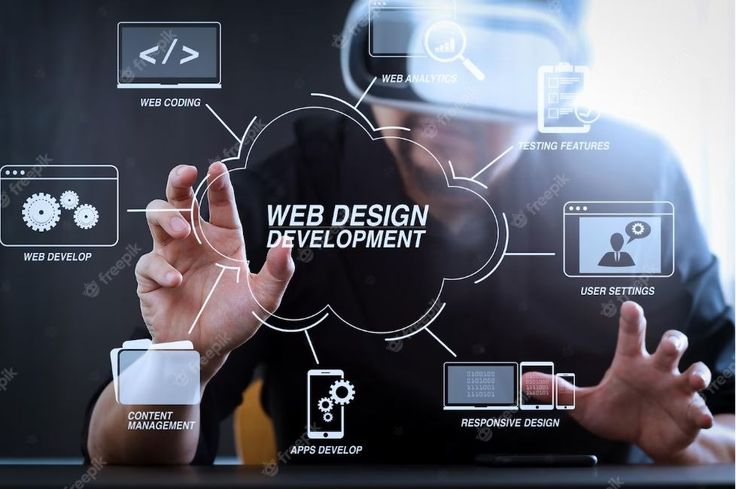
Master Website Design and Development in 2025. Our ultimate guide covers essential tips, SEO strategies, and future trends to unlock your online potential.

Website Design and Development is a crucial aspect of establishing a strong online presence in today’s digital landscape. A compelling website is no longer a luxury—it’s a necessity. It’s your digital storefront, your brand’s face, and often the first point of contact with potential customers. This guide will delve into the critical aspects of website design and development, providing actionable insights to help you unlock your online potential and achieve digital success.
Understanding the Synergy: Design and Development)
Many conflate design and development, but they’re distinct yet intertwined. Website design and development requires both skills, and it is important to understand the differences. Website design focuses on the aesthetic and user experience (UX), while development translates those designs into a functional, interactive website.
- Website Design:
- Visual Appeal: Creating a visually engaging layout that reflects your brand identity.
- User Experience (UX): Ensuring intuitive navigation, seamless interactions, and a positive user journey.
- User Interface (UI): Designing interactive elements that are both functional and visually pleasing.
- Responsive Design: Adapting the website to various screen sizes and devices.
- Website Development:
- Front-End Development: Building the client-side of the website using HTML, CSS, and JavaScript.
- Back-End Development: Handling server-side logic, databases, and application functionality using languages like Python, PHP, or Node.js.
- Content Management Systems (CMS): Integrating platforms like WordPress, Drupal, or Joomla for easy content management.
Key Factors for SEO-Friendly Website Design)
A visually stunning website is useless if it’s not discoverable. Here’s how to optimize for search engines, a key part of website design and development:
- Mobile-First Approach: Google prioritizes mobile-friendly websites. Ensure your site is responsive and performs well on all devices.
- Page Speed Optimization: Fast-loading websites enhance user experience and improve search rankings. Compress images, minimize code, and leverage caching.
- Keyword Integration: Conduct thorough keyword research and naturally incorporate relevant keywords into page titles, meta descriptions, headings, and content.
- Clean URL Structure: Use short, descriptive, and keyword-rich URLs.
- Image Optimization: Use descriptive alt text for images and optimize image sizes.
- Internal Linking: Create a logical internal linking structure to improve navigation and distribute link equity.
Essential Website Development Practices)
Robust development practices are crucial for a functional and scalable website. When considering website design and development, make sure to implement the following:
- Clean and Efficient Code: Write well-structured, maintainable code that adheres to industry standards.
- Security Best Practices: Implement security measures to protect against vulnerabilities and cyber threats.
- Cross-Browser Compatibility: Ensure your website functions correctly across different browsers.
- Scalability: Design and develop your website with future growth in mind.
- API Integration: Seamlessly integrate third-party APIs for enhanced functionality.
Choosing the Right Platform and Technology)
Selecting the appropriate platform and technology stack is vital for any website design and development project:
- WordPress: A popular CMS for content-driven websites and blogs.
- E-commerce Platforms: Shopify, WooCommerce, and Magento for online stores.
- Custom Development: Tailored solutions for complex projects and unique requirements.
- JavaScript Frameworks: React, Angular, and Vue.js for dynamic and interactive web applications.
The Importance of User Experience (UX))
A positive user experience is paramount for website success. Great UX is a requirement of proper website design and development.
- Intuitive Navigation: Make it easy for users to find what they’re looking for.
- Clear Call-to-Actions (CTAs): Guide users towards desired actions.
- Accessibility: Ensure your website is accessible to users with disabilities.
- Consistent Branding: Maintain a consistent brand identity throughout the website.
Future Trends in Website Design and Development)
Stay ahead of the curve by embracing emerging trends in website design and development:
- AI-Powered Design: AI tools are automating design tasks and enhancing personalization.
- Voice Search Optimization: Optimize your website for voice search queries.
- Progressive Web Apps (PWAs): PWAs offer app-like experiences on the web.
- Dark Mode Design: Dark mode is gaining popularity for its aesthetic appeal and reduced eye strain.
Investing in professional website design and development is an investment in your online success. By prioritizing user experience, SEO, and robust development practices, you can create a website that not only looks great but also drives results. Embrace the evolving digital landscape and unlock your online potential.
Ready to elevate your online presence? Contact us today for expert website design and development services.


No responses yet